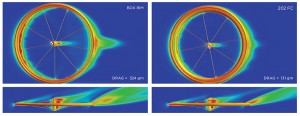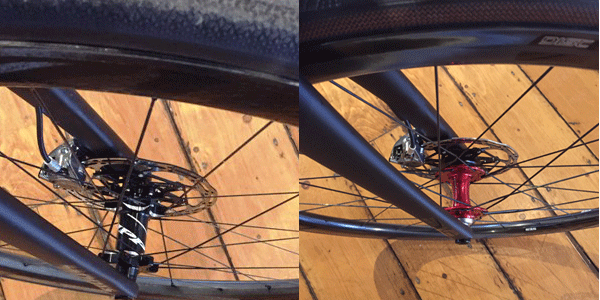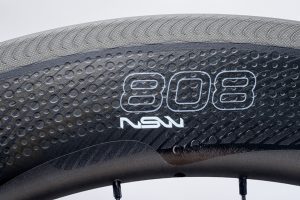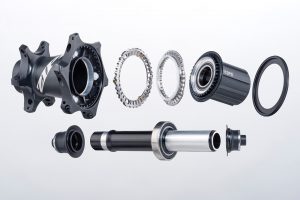Zipp vs. Enve Wheels
Zipp and Enve are two of the most respected and well-known brands in the carbon wheel world for good reason. We’ve represented both for a long-time – Zipp since our inception in ’01 and Enve since not long after their inception, back when they were called Edge Composites.
The hardest thing about trying to compare Zipp and Enve wheels is that their price points and design targets are just different enough that it could be argued that they aren’t directly comparable. For example, do you compare a pair of $2700 Enve wheels with DT hubs to Zipp’s standard hub equipped $2100 wheelset or their $3100 NSW hub equipped model? This being said, the two brands are clear competitors, so let’s break down the most meaningful differences between how the two companies build carbon rim bicycle wheels.
Zipp Versus Enve Carbon Wheel Aerodynamics
 Zipp, along with HED, invented the original toroidal rim shape that continues to play a significant role in aero wheel innovation and design today. There is likely no other company in the bike industry that put as much into aerodynamics research and testing of bicycle wheels as Zipp. The result is features like ABLC dimpling, the radical “whale inspired” Sawtooth rim design on the 454 NSW wheels, and being early players in the development of wide rim profiles. The development of these features have either brought aerodynamics up another level in performance and/or significantly improved stability and predictability in side winds. There is a reason that, like Cervelo when it comes to frames, the baseline comparison wheel that everyone compares is usually a Zipp.
Zipp, along with HED, invented the original toroidal rim shape that continues to play a significant role in aero wheel innovation and design today. There is likely no other company in the bike industry that put as much into aerodynamics research and testing of bicycle wheels as Zipp. The result is features like ABLC dimpling, the radical “whale inspired” Sawtooth rim design on the 454 NSW wheels, and being early players in the development of wide rim profiles. The development of these features have either brought aerodynamics up another level in performance and/or significantly improved stability and predictability in side winds. There is a reason that, like Cervelo when it comes to frames, the baseline comparison wheel that everyone compares is usually a Zipp.
Enve is no slouch in the aerodynamics department either. Enve developed their SES (Smart Enve System) wheel designs with a good deal of aerodynamics research. Enve even went as far as hiring an aerodynamics expert with Formula 1 experience to help – Simon Smart. The result is that Enve wheels compete well aerodynamically with archetypal aerodynamic wheel brands like HED and Zipp. Most riders will find that an Enve rim equipped wheelset is plenty aero and their rim profile is one of the best when it comes to mitigating crosswinds.
While Enve is very competitive, if we are picking an aerodynamics category winner, it is going to be Zipp. Our own aero testing expert and World Champion Pursuit rider Dean Phillips has tested almost every highly aero wheel under the sun and time and time again he keeps ending up riding a pair of Zipp wheels.
Aerodynamic Advantage: Zipp
Zipp Versus Enve Wheel Weight
While you can order the front and rear wheel independently, Zipp tends to keep the depth of their front and rear wheels in a pair of wheels the same. Enve, on the other hand, usually pairs a lower profile front wheel with a 10mm deeper rear. This makes it a little difficult to directly compare wheel weights. This being said, I think it is fair argument that the Enve SES 4.5 is designed to directly compete with the Zipp 303 NSW. A pair of caliper brake clincher SES 4.5 with DT hubs is 1328 grams and a pair of 303 NSW is 1420 grams. Similar differences exist across the disc brake equipped wheels as well and the difference becomes a little bigger as the rims get deeper (Enve 7.8 are about 150 grams lighter than a Zipp 808 NSW). If you compare tubular rim options, the difference usually falls between 50 and 90 grams, with the Enve being lighter.
If light weight at a given depth is your primary target, Enve holds the advantage.
Wheel Weight: Advantage Enve
Zipp Versus Enve Hubs and Wheel Service
There are some real differences in philosophy between Zipp and Enve wheels in terms of design, maintenance and the ease of service. Zipp is 100% committed to building a wheel system. Zipp no longer sells rims that can be laced to the hub of your choice. Instead, they design and spec the hub, the rim and the spokes to work as a system. Enve takes a different approach. Enve builds rims and they offer their rims built up on hubs from a variety of manufacturers. The results are wheels that each have service benefits, but in different ways.
Hubs – In addition to their own carbon hubs, Enve offers hubs from DT and Chris King. You can also get Enve rims and build most any hub you want into them. This approach lets you select a hub based on ease of service or any other variable that you value. In our experience, Chris King hubs need very little long-term service, DT hubs are not far behind and the Enve hub (which uses DT internals) require a little more as the design is ultralight and minimalist. If max speed is your goal, a DT240 (or, even better, having us custom build a pair of DT180 hubs onto a pair of Enve rims) is a good bet. If minimal service and custom colors are your primary goal, you will not go wrong with Chris King hubs.

Zipp offers three different levels of hub on their carbon wheels – the 76/176, the 77/177 and the Cognition. The 76/176 hubset is found in Zipp’s lowest priced carbon wheelset – the 302. The 76/176 uses a standard J-Bend spoke and a basic and proven hub design with Zipp’s most protected bearings and seals. While this is a relatively basic hub, and doesn’t get the nicer Swiss bearings Zipp is well known for, the bearings can be upgraded. The Zipp 302 is a really nice riding wheel that outperforms the venerable (and significantly more expensive) 404 from just a generation or two ago on a number of fronts.
The 77/177 hubs come in Zipp’s middle price tier wheels (wheels just over $2000 a pair). In addition to the usual 11 speed cassette options from Campagnolo and Shimano, the 177 rear hub offers the ability to be set-up with a XDR cassette body. If you want to use one of SRAM’s innovative XDR cassettes (for wide ratio double or 1x), which have gearing ranges as wide as 10-50, XDR is the ticket. The 77/177 hubs use straight-pull spokes, which eliminate the weakest point on the spoke – the bend at the hub. The seals on the 77/177 are more robust than past Zipp hubs and Zipp uses high-grade Swiss made steel bearings. In our experience, these bearings offer performance that is better than a number of ceramic bearings on the market. Past Zipp hubs have required annual bearing service for riders who are in the rain with any regularity. While not sealed up like a Chris King, the new 77/177 has cut the need for regular bearing service down nicely compared to past Zipp offerings while providing lower mechanical seal resistance than a Chris King.
The top of the line Zipp NSW wheels use the Cognition hub. The Cognition is a pretty unique hub. Zipp Cognition hubs use an axial clutch design with magnets, instead of pawls and springs, to eliminate hub friction when coasting. Zipp also claims that the magnet based system on the Cognition rear hub engages quicker than most pawls. We’re not convinced the latter always holds true, but we can tell you that Zipp Cognition hubs are very fast when you are coasting or descending. Like the 177, the Cognition hub can have a XDR cassette body installed and includes the same precision stainless steel ABEC 5 Swiss bearings that have long been part of why Zipp wheels almost always tend to roll and coast better than many others. If you want to maximize speed, Cognition hubs are a good way to do it.
This being said, generally speaking, the faster the hub, the more you need to pay attention to bearing service. The best way to protect bearings is with heavy duty seals and goopy and heavy grease. This is also the best way to make bearings spin sluggishly and a wheel slow… Conversely, the best way to make bearings spin great is light viscosity grease paired with lighter seals for lower friction. The hubs found on Firecrest and NSW Zipp wheels prioritize speed.
Spoke Nipples – Zipp uses spoke nipples that are outside the rim. If your wheel goes out of true, you don’t need to remove the tire and rim strip to true it. Enve uses spokes where the nipple is inside the rim, arguing that they can build stronger spoke holes this way and improve aerodynamics. Mechanically, we’re fans of external spoke nipples. We’re also pretty sure that Zipp would put the nipples inside if they thought there was a worthwhile aero benefit. This being said, once the spokes are settled, many riders can ride years without needing a wheel true. You need to know yourself as to whether one wheel or the other offers value to you in this regard.
Hub Advantage – While it is a bit more complicated than this, we’re going to call Zipp the winner if you value pure speed over service intervals while Enve (with Chris King hubs) prevails if you value service intervals over absolute top speed.
Wheel Truing Advantage- Zipp. While both brands are better than ever in terms of how often they need to be trued, external nipples are easier to true.
Zipp Versus Enve Wheel Responsiveness and Lateral Stiffness
Because of the differences in hubs and rim depths offered, this is a difficult category to make a direct comparison. With the exception of some of the lightest full carbon wheels (Lightweight, Reynolds RZR), wheel weight and stiffness can often be inversely proportionate. Enve’s lightest rim, hub and spoke hub combination is the Enve SES 2.2 with Enve carbon hubs. While Enve does not declare a maximum rider weight on these wheels, we have seen evidence that this combination is not great for some riders as light as 160 lbs. We haven’t seen the same with recent versions of the moderately heavier Zipp 202.
We don’t have the ability to deflection test rims and wheels across the full range of product from each company. Even if we did, overall wheel stiffness is a combination of spokes, hubs and rims. While this could be tested with Zipp, who only sells complete wheels with factory hubs and spokes, Enve offers an array of hubs from the factory, as well as the option to build your own wheels with spokes and rims to suit. If we are speaking in generalities, heavier rims are normally stiffer rims. If you are over 150 lbs and produce above average power, it can be worth giving up 100 grams in weight to gain stiffness.
Wheel Responsiveness Advantage – The bottom line is that you need to determine how stiff is stiff enough for you. This will be different rider to rider. This is a dead heat category until you start drilling down to comparing individual wheel models within the line for your use. Contact us if you want an opinion on what option(s) are best for you as an individual.
Zipp Versus Enve Braking
Let’s point out the obvious – if you are using disc brakes, this section matters little. Yes, there are some Zipp wheels that currently only accept 6-bolt rotors (303), and thus can’t use some of Shimano’s most advanced cenerlock rotors with them, but these exceptions are becoming more of a scarcity by the day. Regardless, we’re not going to talk about disc brake braking comparing Zipp and Enve wheels. What about caliper brakes?

Both Zipp and Enve have been at the forefront of improving carbon clincher braking performance. The latest generation braking tracks offered by both companies means that there is no longer a huge delta between stopping with aluminum and carbon rims across wet and dry conditions. Enve calls their technology “Textured Full Carbon Brake Track” while Zipp’s best performing brake track is called “Showstopper”. Enve textured braking surfaces and Zipp Showstopper offer similar performance in the dry; both Zipp and Enve are at the top of the category in terms of carbon rim braking performance. We’ll give Enve braking the advantage in the wet though. The Zipp Showstopper brake track is better than many carbon rims, including Firecrest, but isn’t as inspiring as the Enve in the wet. This being stated, if you ride a lot in the wet, you should likely be looking at a disc brake bike…
It is important to note that the brake track is part of what makes the top of the line NSW rims different from the standard Firecrest. The Firecrest braking track is not Showstopper. This is one place where things become complicated comparing Zipp and Enve and where the differences could sway you one way or another. All current generation Enve rims offer the Textured Full Carbon Brake Track. So, if you value the best performing caliper braking over all else, and are trying to minimize your costs to get it, an Enve with a DT240 hub is usually the way to get this. On the other hand, if you are willing to give up some braking performance, particularly in wet conditions, you can get into a Zipp Firecrest equipped wheel for well over $500 a pair less than the lowest priced Enve.
Braking Advantage: Enve as they offer the best braking at the lowest price. As of June 2018, Zipp put their Showstopper braking surface on many of their Firecrest wheels, thus making Zipp the new leader from a price perspective. Enve is the winner for overall braking performance. Zipp wins for price to performance ratio. (Updated. June 2018.)
Zipp Versus Enve Wheels. Tubeless Ready?
Over the past few years, both Zipp and Enve have made almost all of their latest generation rim introductions tubeless ready. While we have read reviews that mention that this isn’t important if you are a performance based rider, we beg to differ. The latest tubeless road tires, like the Schwalbe Pro One, have really started to come into their own as of late, offering some of the lowest rolling resistance numbers on the market, while simultaneously eliminating pinch flats and offering an exceptional ride. We expect more race capable tubeless tire designs in the future. If you are investing in a nice new carbon clincher wheelset, having it be tubeless ready has some nice benefits and no disadvantages.
 While all current Enve rims are tubeless compatible, if you want tubeless on a Zipp, it is important to check the specific wheelset you are interested. For example, at the moment, Zipp’s 303 caliper brake wheels are not tubeless ready, but the disc brake version of the same wheel is. It will not be too long before almost every wheel will likely be tubeless compatible, but we aren’t quite there yet. For now, check the exact model and brake type you want before you buy.
While all current Enve rims are tubeless compatible, if you want tubeless on a Zipp, it is important to check the specific wheelset you are interested. For example, at the moment, Zipp’s 303 caliper brake wheels are not tubeless ready, but the disc brake version of the same wheel is. It will not be too long before almost every wheel will likely be tubeless compatible, but we aren’t quite there yet. For now, check the exact model and brake type you want before you buy.
Tubeless Ready Advantage: Zipp has the advantage when it comes to offering tubeless at a lower price than Enve. Enve holds the advantage for having all their clincher rims be tubeless ready today.
Zipp Wheels Versus Enve Wheels – Price
Price is a particularly difficult thing to compare between Zipp wheels and Enve wheels. Why? Their hub offerings are arguably not directly comparable and Enve makes one level of rim while Zipp offers three. So, while Zipp carbon wheels start at $1500, Enve’s start about $1000 more. We won’t even try to compare things in terms of price – it all comes down to what you value and what you are looking for. If you want the best rim braking at the lowest price, get an Enve built on DT 240 hubs. If you want the lowest priced high quality carbon wheel on the market, get a Zipp 302. If you aren’t so concerned about price and want the most roll speed and aerodynamics, get a Zipp NSW or have us built a pair of Enve rims on DT 180 hubs.
Price Advantage: Zipp for just starting at a lower price point. This advantage is not so clear cut when it comes to comparing Enve to Zipp NSW wheels.
Zipp vs. Enve Aesthetics
 Both Zipp and Enve offer options for colored logo graphics. Enve has played as big a role as any in the industry in the popularization for the sophisticated wax look matte black finish. Zipp, on the other hand, has often made bold graphics and textured finishes part of their culture. If you want to get anodized hubs to match the sweet anodization on your new custom ti frame, you’ll want to head to Enve, where you can order rims and have them built with hubs of your choice. Otherwise, this category comes down to whether you prefer more eclectic or a more universal aesthetic.
Both Zipp and Enve offer options for colored logo graphics. Enve has played as big a role as any in the industry in the popularization for the sophisticated wax look matte black finish. Zipp, on the other hand, has often made bold graphics and textured finishes part of their culture. If you want to get anodized hubs to match the sweet anodization on your new custom ti frame, you’ll want to head to Enve, where you can order rims and have them built with hubs of your choice. Otherwise, this category comes down to whether you prefer more eclectic or a more universal aesthetic.
On a related note, both Enve and Zipp offer stems, seatposts and handlebars that match their wheels.
Aesthetic Advantage: Aesthetics are up to the individual. If you want to know my tastes, I tend to lean towards the Enve aesthetic, but I have plenty of Zipp parts on various bikes…
Zipp Versus Enve Warranty
Two years for Zipp. Five years for Enve.
Both companies offer competitive “no fault” replacement and repair programs for issues outside of warranty. Usually, if a warranty failure is going to happen, it occurs near the beginning of the service life of the product.
Warranty Advantage: Both companies stand behind their product. Zipp’s parent company is SRAM. SRAM has one of the most responsive and supportive customer service departments in the business. Enve’s parent company is Mavic and they don’t have things quite as together as SRAM in this department. This being said, it is hard to fault a five year warranty; Enve gets the nod based on simple duration of warranty.
Zipp Versus Enve Wheel Conclusions
Both Zipp and Enve’s lines are evolving. This has meant that while some of the more recently updated models may be tubeless ready or have the latest high performance braking track, others do not. For example, for 2018, the Zipp 303 Firecrest caliper brake wheelset is not designed for use with tubeless tires, but the 303 Firecrest disc brake wheelset is equipped with a tubeless compatible rim. So, look at the exact wheel you are interested and don’t assume that if one wheel in a series has a feature the rest do.

If your goal is outright speed, get a pair of current Zipp NSW wheels. When it comes to the hubs, the Cognition hubs on the Zipp NSW with the axial clutch hub and Swiss bearings are arguably as fast as you can get. When it comes to the rims, no one has been more creative or followed the data from their test results more than Zipp. At a given depth, if the Zipp NSW is not the most aero wheel you can buy, it will be very, very close. Likewise, if you are looking for wheels more in the $2000 range, the standard Zipp offerings are possibly the fastest wheels in their categories. Even the $1500 Zipp 302, which uses “old” Zipp rim technology, is a very fast wheel that few other ~50mm depth wheels in its price range can touch. In other words, from a performance standpoint, if you want a safe bet, you won’t go wrong with a Zipp wheel.
So, if Zipp wheels are almost universally at the top of the speed charts for their price, why would you buy anything else? Because there are other wheels that can be built to be of very similar speed to a Zipp and many riders have other considerations. From wet weather rim braking performance to the different benefits and considerations of being able to select from a variety of hubs, Enve has a lot to talk about. This is why we recommend that you talk to folks with experience with both brands across a wide array of uses, rider weights, power profiles and with different frames to select a wheel that makes the most sense for you.
Contact us if you have questions or want to talk wheels.
